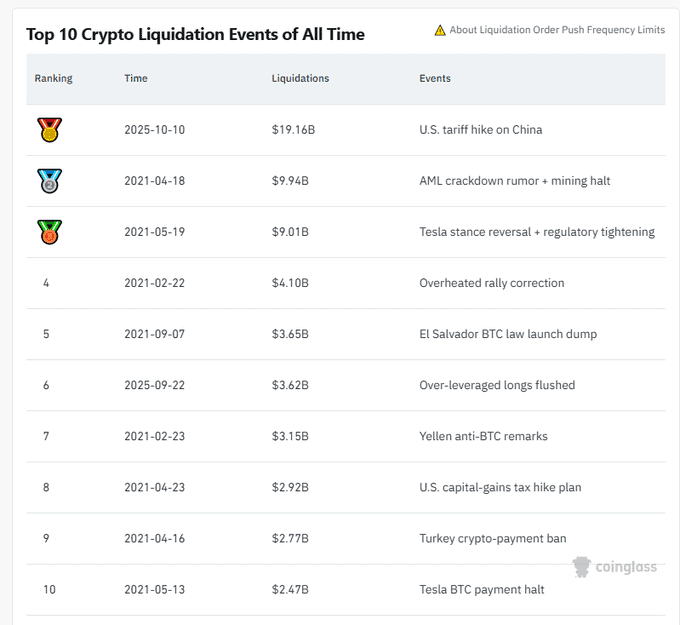
The largest liquidation events in crypto history show how macroeconomic factors, corporate decisions, and regulations have impacted the market. The most recent record, $19.160 billion liquidated, was recorded this month.
According to data from Coinglass, the largest liquidation event in cryptocurrency history was recorded on October 10. That day, the crypto market suffered losses of $19.160 billion, driven by the announcement of increased US tariffs on China. The magnitude of the episode far exceeded the peaks of 2021, when liquidations of between $9.000 and $10.000 billion marked days of high volatility for users and investors.
To understand why these events occur, it's important to clarify that cryptocurrency liquidations occur when prices drop abruptly and leveraged traders are unable to cover their positions. In this scenario, platforms automatically liquidate contracts to avoid further losses, creating a domino effect that accelerates market price declines. This mechanism, typical of derivatives markets, explains why political or corporate announcements can trigger such violent movements in a matter of hours.
Trade crypto securely and securely with Bit2Me.From Tesla to Türkiye: The Triggers of the 2021 Crypto Sell-Offs
The year 2021 went down as one of the most volatile in the industry's history. On May 18, rumors of tightening anti-money laundering and anti-corruption regulations surfaced. Suspension of crypto mining operations in China triggered liquidations of $9.940 billion. Just a month earlier, on May 19, the Tesla's reversal of accepting Bitcoin payments, coupled with signs of increased regulatory pressure, had generated losses of $9.190 billion.
That same year, other episodes occurred that reflect the sensitivity of the cryptocurrency market to external factors. On February 22, a correction after an overheated rally erased $4.100 billion in positions. On September 7, the Entry into force of the Bitcoin Law in El Salvador, which made cryptocurrency legal tender in that country, coincided with a sharp sell-off that netted $3.650 billion.
Likewise, Anti-BTC statements by then-US Treasury Secretary Janet Yellen, on November 23, generated settlements for about $3.150 billion, while on September 22, plans to increase the capital gains tax In that country they caused losses of 2.780 billion dollars.
On the most volatile days, trade with confidence on Bit2MeBut, in addition to the United States, Türkiye has also played an important role in this cycle of liquidations: on April 16 of the same year, the ban on cryptocurrency payments triggered liquidations of around $2.770 billion. Finally, on May 13, Tesla shocked the market again by suspending Bitcoin payments., which resulted in another $2.470 billion in liquidated contracts.

All of these liquidation episodes show how the combination of political decisions, regulatory changes, and corporate shifts can immediately alter market equilibrium. In all cases, the common denominator was the high level of leverage that characterized retail and institutional operators during that cycle.
Trust, security, and liquidity: all at Bit2MeThe October 10 Shock: Tariffs, Panic, and Record Crypto Liquidations
The event of October 10, 2025, surpassed all previous records. Washington's decision to increase tariffs on Chinese products rekindled trade tensions between the world's two largest economies. The announcement sparked a shift toward risk aversion in global markets, and the crypto sector was no exception.
The impact was immediate. Bitcoin and Ether prices plummeted, and leveraged positions began to be liquidated in a cascade. Within hours, the total reached $19.160 billion, nearly double the largest recorded episodes of 2021. The magnitude of the adjustment reflected not only the market's sensitivity to macroeconomic factors but also traders' level of exposure to futures and derivatives contracts.
Mass liquidations often amplify price movements because they force the automatic sale of assets. As contracts close, selling pressure increases and prices fall further, triggering further liquidations. This vicious cycle explains why trade or monetary policy announcements can have a disproportionate effect on the crypto market.
However, after several days of volatility, the market began to show signs of stabilization. Bitcoin recovered some of its lost ground And the financing indicators on exchanges reflected a reduction in the level of leverage. Analysts consulted by financial media indicated that the correction could serve as a healthy adjustment, reducing the excess risk accumulated in previous weeks.
Create your account and access crypto securelyThe lesson learned about excessive leverage in the crypto market
Coinglass data allows for a clear narrative: the largest liquidation events in the history of the crypto market have been linked to external factors ranging from corporate decisions to tax and trade policies. October's record confirms that, despite growing institutional adoption, the sector remains vulnerable to macroeconomic shocks and leverage dynamics.
The 2021 experience had already shown how the combination of regulatory rumors, corporate reversals, and national measures could trigger multi-million-dollar losses in a matter of hours. The new episode in 2025, with unprecedented liquidated volume, reinforces the need to understand how futures contracts work and the risk involved in trading with leverage in such a volatile market.
Thus, although the crypto market has begun to recover after the October shock, the lesson remains. The interaction between global politics and derivatives dynamics will continue to mark the most critical moments in the sector. For investors and traders, the key is to recognize that liquidations are not simple accidents, but a reminder that risk management is just as important as seeking profit opportunities. Therefore, many believe that this correction, rather than a setback, can be seen as a necessary adjustment that helps clear the excess risk accumulated in previous weeks.

Main Cryptocurrencies Course
Basic levelBit2Me Academy brings you a new course in which you will learn everything you need about the most important cryptocurrencies that exist today.


